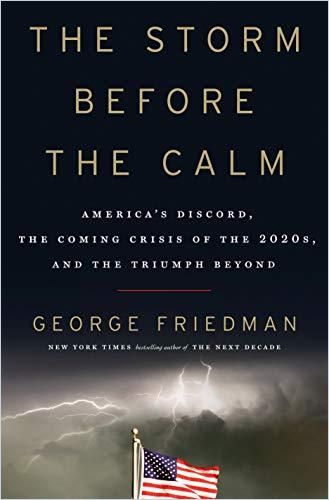Leading futurist and New York Times bestselling author George Friedman views the United States through the prism of constant, opposing economic and political cycles.

Cyclical Changes Drive America
Futurist George Friedman, founder and chairman of Geopolitical Futures, a forecasting company, has already written two New York Times bestsellers, The Next Decade and The Next 100 Years. In this intriguing study, Friedman argues that the United States stands on the cusp of a wrenching but necessary period that will clear the way for new prosperity. Putting great stock in historical cycles and explaining their effects on US political, social and economic fortunes, he posits that America is due for a reset in the 2020s. This illuminating work will appeal to students of history and to investors, politicians and anyone with an interest in the future of the United States.
Bloomberg named this one of its Best Books of the Year. The Wall Street Journal called it a “prescient anticipation of our current woe…the book contains real insights.” Douglas Duncan, chief economist for Fannie Mae, praised the book’s value for a general audience but emphasized that it “is essential reading for anyone with a role in strategic planning. It combines clear, interesting prose with a thought-provoking projection of upcoming challenges and ultimate outcomes.”
Outsized Importance
Friedman explains that, regardless of who has held the office – George Washington, Abraham Lincoln or Donald Trump – Americans focus too much attention on the presidency.
We have to remember that presidents are simply the street signs. The cycle is working itself out in the murky depths.(George Friedman)
Friedman notes that American presidents have less authority than European prime ministers, and he details how the US Constitution’s framers devised a separation of powers that reined in presidential clout and enabled the courts to override Congress and the executive branch. He argues that, from the beginning, the US was a commercial undertaking: The colonies were profit-seeking ventures established by investors in fur trading, plantation agriculture and anything else that could make money.
Predictable Patterns
Friedman cites predictable patterns that he finds govern US history. What he calls the “institutional cycle” relates to government’s internal functioning and how it interacts with society. He maintains these phases last about 80 years, which means the current institutional cycle ends in 2025. “Socioeconomic cycles,” in his analysis, typically last about 50 years; the current phase should end in the mid-2020s. The author reports that widespread social and economic pain attend the conclusion of every socioeconomic cycle. Friedman sees technocracy, in which experts run government and society, as dominating the current phase. This, he point out, leads to layers of federal bureaucracy and turf battles among agencies.
The United States periodically reaches a point of crisis in which it appears to be at war with itself, yet after an extended period it reinvents itself, in a form both faithful to its founding and radically different from what had been.(George Friedman)
Friedman says America finds itself at a confused moment: It never sought to run an empire, and yet 18 years of Middle East warfare have taken a severe toll. Friedman asserts that, because the United States’ foundation had a stated moral purpose, political debate roils over its role in the world.
Education
Friedman recounts that the previous 50-year socioeconomic cycle ended with a shortage of capital in the 1970s, but the current one will wind down with a surfeit of capital and a dearth of investment opportunities. He recognizes that Americans fight for entry to the technocracy, a source of lucrative jobs. However, the white working class remains barred from prosperity, and Black Americans, he laments, stand on the outside, looking in. Friedman foresees blue-collar workers being unable to buy homes or take vacations or pay for their children’s education. He has hopes, however, for a political alliance between working-class white and Black Americans.
Painful Transition
Friedman predicts a decade of political animus, seething rage and a sense that the United States has lost its way. But then, he believes, the storm will pass and a period of tranquility and prosperity will begin.
Forecaster
Friedman has written and consulted at the highest levels of education and business for decades. He regularly turns out new works with original premises that align with the current zeitgeist’s concerns. That is no small feat. Friedman garners off-kilter, illustrative examples that few other authors undertake to explain. His eloquent linking of these examples often feels like groundbreaking perceptions. On closer examination, however, some seem more like editorial-page generalizations. Friedman also has an unfortunate tendency to bloviate, and there might be 25% more of this book than necessary.
But few authors plow this territory and none with Friedman’s experience, credentials or broad-based perspective. Investors and others compelled by well-founded conclusions about America’s present and future will find Friedman a source of insights: some startling, some worth backing with hard cash and some just fodder for dinner table conversation.
If this book piques your interest, you will likely want to read Friedman’s Flashpoints and America’s Secret War, Peter Ziehan’s Disunited Nations and Marko Papic’s Geopolitical Alpha.





